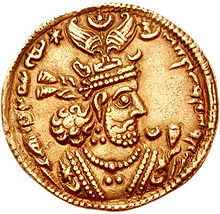
Back Chosrau II. ALS كسرى الثاني Arabic كسرى التانى ARZ II Xosrov Azerbaijani خسرو پرویز AZB Хосров II Парвиз Bulgarian দ্বিতীয় খসরু Bengali/Bangla Cosroes II Catalan Husrav II. Czech Khosrau 2. Danish
| Khosrow II 𐭧𐭥𐭮𐭫𐭥𐭣𐭩 | |
|---|---|
| King of Kings of Iran and non-Iran[a] | |
 Gold dinar of Khosrow II, minted in 611 | |
| Shahanshah of the Sasanian Empire | |
| 1st reign | 590 |
| Predecessor | Hormizd IV |
| Successor | Bahram Chobin |
| 2nd reign | 591 – 25 February 628 |
| Predecessor | Bahram Chobin |
| Successor | Kavad II |
| Born | c. 570 |
| Died | 28 February 628 (aged around 57–58) Ctesiphon |
| Consort | |
| Issue | See below |
| House | House of Sasan |
| Father | Hormizd IV |
| Mother | Unnamed Ispahbudhan noblewoman |
| Religion | Zoroastrianism |
Khosrow II (spelled Chosroes II in classical sources; Middle Persian: 𐭧𐭥𐭮𐭫𐭥𐭣𐭩, romanized: Husrō and Khosrau), commonly known as Khosrow Parviz (New Persian: خسرو پرویز, "Khosrow the Victorious"), is considered to be the last great Sasanian king (shah) of Iran, ruling from 590 to 628, with an interruption of one year.[1]
Khosrow II was the son of Hormizd IV (reigned 579–590), and the grandson of Khosrow I (reigned 531–579). He was the last king of Iran to have a lengthy reign before the Muslim conquest of Iran, which began five years after his execution. He lost his throne, then recovered it with the help of the Byzantine emperor Maurice, and, a decade later, went on to emulate the feats of the Achaemenids, conquering the rich Roman provinces of the Middle East; much of his reign was spent in wars with the Byzantine Empire and struggling against usurpers such as Bahram Chobin and Vistahm.
Khosrow II began a war against the Byzantines in 602, ostensibly to avenge the murder of his ally Maurice. Persian forces captured much of the Byzantine Empire's territories, earning Khosrow II the epithet "the Victorious". A siege of the Byzantine capital of Constantinople in 626 was unsuccessful, and Heraclius, now allied with Turks, started a risky but successful counterattack deep into Persia's heartland. Dissatisfied with the war, the feudal families of the empire supported a coup in which Khosrow II was deposed and killed by his estranged son Sheroe, who took power as Kavad II. This led to a civil war and interregnum in the empire and the reversal of all Sasanian gains in the war against the Byzantines.
In works of Persian literature such as the Ferdowsi's Shahnameh and Nizami Ganjavi's (1141–1209) Khosrow and Shirin, a famous tragic romance and a highly elaborated fictional version of Khosrow's life made him one of the greatest heroes of the culture, as much a lover as a king. Khosrow and Shirin tells the story of his love for the Armenian/Roman (originally Aramean) princess Shirin, who becomes his queen after a lengthy courtship strewn with mishaps and difficulties.
Cite error: There are <ref group=lower-alpha> tags or {{efn}} templates on this page, but the references will not show without a {{reflist|group=lower-alpha}} template or {{notelist}} template (see the help page).
© MMXXIII Rich X Search. We shall prevail. All rights reserved. Rich X Search